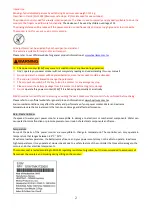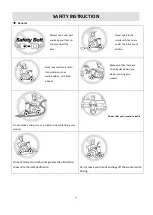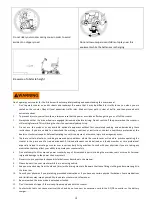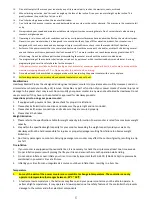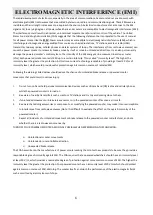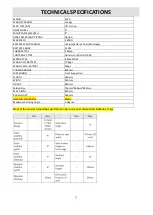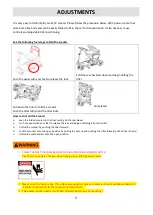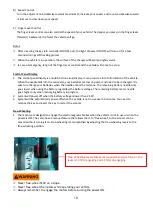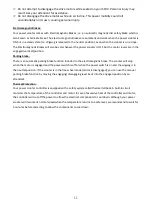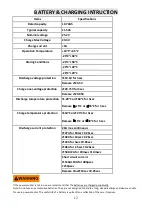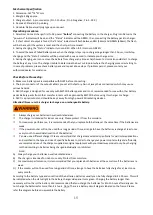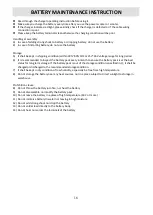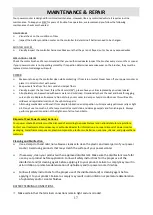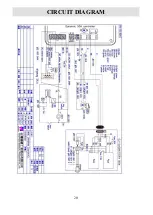
5
14.
Do not attempt to lift or move your scooter by any of its removal parts, such as the armrests, seats, or shroud.
15.
When climbing an incline, don’t drive at an angle up the face of the incline. Drive your scooter straight up the incline. This
greatly reduces the possibility of a tip or a fall.
16.
Don’t climb a slope steeper than the scooter’s limitation.
17.
Don’t attempt to have your scooter proceed backward down any step, curb or other obstacle. This may cause the scooter to fall
or tip.
18.
Always reduce your speed and maintain a stable center of gravity when cornering sharply. Don’t corner sharply when driving
scooters at higher speeds.
19.
Operating in rain, snow, salt, mist conditions and on icy or slippery surfaces may have an adverse affect on the electrical system.
20.
Never sit on your scooter when it is being used in connection with any type of lift or elevation product. Your scooter is not
designed with such use in mind and any damage or injury incurred from such use is not the responsibility of Heartway.
21.
Surfaces of the power scooter that can come into direct contact with the occupant’s skin and/or assistant’s skin during normal
use and that are within occupant reach shall not exceed 41 °C. The motor surface can reach temperatures greater than 41°C
after driving. Do not touch these parts when disassembling the scooter or wait until the motor is cooled down.
22.
The programming of the controller shall only be carried out by personnel, which is authorized by his manufacturer. A wrong
programming can result in safety hazards for the occupant!
23.
If the power scooter is switched off while driving on the horizontal at maximum speed at 6 km/h, it will come to a stop with the
maximum stopping distance of 1.2 m. Please consider this distance when driving.
24.
Drive-wheel needs to be switched to engaged-mode while transporting the power scooter with a car or airplane.
25.
Surface temperatures can increase when exposed to external sources of heat.
Modifications
Heartway Medical Product has designed and engineered power scooters to provide maximum utility. However, under no
circumstances should you modify, add, remove, or disable any part or function of your power scooter. Personal injury and
damage to the power chair may result. Do not modify your power scooter in any way not authorized by Heartway. Do not
use accessories if they have not been tested or approved for Heartway products.
Inspections prior to using your power scooter:
1.
If equipped with pneumatic tires, please check for proper tire inflations.
2.
Please check all electrical connections and make sure they are tight and not corroded.
3.
Please check all harness connections and make sure they are secured properly.
4.
Please check the brakes.
Weight limitation.
1.
Please refer to the specifications table for weight capacity information. Power scooter is rated for a maximum weight
capacity.
2.
Stay within the specified weight capacity for your scooter. Exceeding the weight capacity voids your warranty.
Heartway will not be held responsible for injuries or property damage resulting from failure to observe weight
limitations.
3.
Don’t carry passengers on scooters. Carrying passengers on scooter may affect the center of gravity, resulting in a tip
or a fall.
Tire inflation
1.
If your scooter is equipped with pneumatic tires, it is necessary to check the air pressure at least one time a week.
2.
Proper inflation pressures will prolong the life your tires and ensure the smooth operation while riding.
3.
Do not under-inflate or over-inflate your tires. It is critically important that 30-35 PSI (206-241 kPa) tire pressure be
maintained in pneumatic tires at all times.
4.
Inflating your tires from an unregulated air source could over-inflate them, resulting in a burs tire.
Temperature
1.
Some of the parts of the power scooter are susceptible to change in temperature. The controller can only
operate in temperature that ranges between -25°C ~ 50°C.
2.
At extreme low temperatures, the batteries may freeze, and your power scooter may not be able to operate. In
extreme high temperatures, it may operate at slower speeds due to a safety feature of the controller that prevents
damage to the motors and other electrical components.
Summary of Contents for S19V
Page 20: ...20 CIRCUIT DIAGRAM...
Page 21: ...21 BOM LIST DRAWING...


